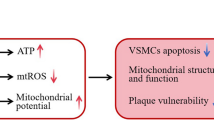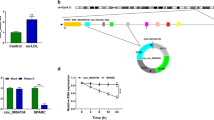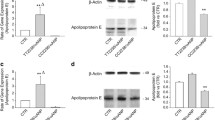Abstract
Homocysteine (Hcy) is considered an independent risk factor for various cardiovascular diseases including atherosclerosis which is associated with lipid metabolism, inflammation, and oxidative stress. Results from our previous study suggested that Hcy-induced atherosclerosis could be reversed by Herpud1 knockout which inhibits vascular smooth muscle cell (VSMC) phenotype switching. Here, we aim to investigate more precise mechanisms behind the improvement in Hcy-induced atherosclerosis. Amyloid-β40 (Aβ40), a vital protein in Alzheimer disease (AD), has been regarded as an important component in the atherosclerosis program in recent years due to the biological similarity between AD and atherosclerosis. Thus, we determined to assess the value of Aβ40 in a Herpud1 knockout Hcy-induced atherosclerosis mouse model by measuring Aβ40 expression in tissue and biomarkers of lipid metabolism, inflammation, and oxidative stress in serum. Additionally, since endothelial dysfunction plays a prominent role in atherosclerosis, we tested human umbilical vein endothelial cell (HUVEC) function following Herpud1 silencing in vitro and evaluated JNK/AP1 signaling activation in our models because of its close relationship with Aβ40. As a result, our animal models showed that Herpud1 knockout reduced Aβ40 expression, inflammation, and oxidative stress levels other than lipid metabolism and alleviated atherosclerosis via JNK/AP1 signaling inhibition. Similarly, our cell experiments implied that Hcy-induced Aβ40 elevation and HUVEC dysfunction involving cell proliferation and apoptosis could be restored by Herpud1 silence through restraining JNK/AP1 pathway. Collectively, our study demonstrates that Herpud1 deficiency could reduce Aβ40 expression, thereby suppressing Hcy-induced atherosclerosis by blocking the JNK/AP1 pathway. This may provide novel potential targets for atherosclerosis prevention or treatment.




Similar content being viewed by others
References
Akhter R, Sanphui P, Das H, Saha P, Biswas SC (2015) The regulation of p53 up-regulated modulator of apoptosis by JNK/c-Jun pathway in beta-amyloid-induced neuron death. J Neurochem 134:1091–1103. https://doi.org/10.1111/jnc.13128
Audagnotto M, Kengo Lorkowski A, Dal Peraro M (2018) Recruitment of the amyloid precursor protein by gamma-secretase at the synaptic plasma membrane. Biochem Biophys Res Commun 498:334–341. https://doi.org/10.1016/j.bbrc.2017.10.164
Austin SA, Combs CK (2010) Amyloid precursor protein mediates monocyte adhesion in AD tissue and apoE(−)/(−) mice. Neurobiol Aging 31:1854–1866. https://doi.org/10.1016/j.neurobiolaging.2008.10.013
Bamji-Mirza M, Callaghan D, Najem D, Shen S, Hasim MS, Yang Z, Zhang W (2014) Stimulation of insulin signaling and inhibition of JNK-AP1 activation protect cells from amyloid-beta-induced signaling dysregulation and inflammatory response. J Alzheimers Dis 40:105–122. https://doi.org/10.3233/JAD-131949
Biberoglu K, Yuksel M, Tacal O (2019) Azure B affects amyloid precursor protein metabolism in PS70cells. Chem Biol Interact 299:88–93. https://doi.org/10.1016/j.cbi.2018.11.023
Boushey CJ, Beresford SA, Omenn GS, Motulsky AG (1995) A quantitative assessment of plasma homocysteine as a risk factor for vascular disease. Probable benefits of increasing folic acid intakes. JAMA 274:1049–1057. https://doi.org/10.1001/jama.1995.03530130055028
Chandra D, Gupta A, Strollo PJ Jr, Fuhrman CR, Leader JK, Bon J, Slivka WA, Shoushtari AH, Avolio J, Kip KE, Reis S, Sciurba FC (2016) Airflow limitation and endothelial dysfunction. Unrelated and independent predictors of atherosclerosis. Am J Respir Crit Care Med 194:38–47. https://doi.org/10.1164/rccm.201510-2093OC
Chang X, Salim A, Dorajoo R, Han Y, Khor CC, van Dam RM, Yuan JM, Koh WP, Liu J, Goh DY, Wang X, Teo YY, Friedlander Y, Heng CK (2017) Utility of genetic and non-genetic risk factors in predicting coronary heart disease in Singaporean Chinese. Eur J Prev Cardiol 24:153–160. https://doi.org/10.1177/2047487316676609
Dekou V, Whincup P, Papacosta O, Ebrahim S, Lennon L, Ueland PM, Refsum H, Humphries SE, Gudnason V (2001) The effect of the C677T and A1298C polymorphisms in the methylenetetrahydrofolate reductase gene on homocysteine levels in elderly men and women from the British regional heart study. Atherosclerosis 154:659–666
Ding W, Chen R, Wu C, Chen W, Zhang H, Fan X, Wang H, Ji Y, Xie L, Ning X, Shen L (2017) Increased expression of HERPUD1 involves in neuronal apoptosis after intracerebral hemorrhage. Brain Res Bull 128:40–47. https://doi.org/10.1016/j.brainresbull.2016.11.006
Ding X, Wang X, Zhu X, Zhang J, Zhu Y, Shao X, Zhou X (2020) JNK/AP1 pathway regulates MYC expression and BCR signaling through Ig enhancers in Burkitt lymphoma cells. J Cancer 11:610–618. https://doi.org/10.7150/jca.34055
Fredman G (2019) Resolving atherosclerosis and Alzheimer disease. Nat Rev Cardiol 16:259–260. https://doi.org/10.1038/s41569-019-0182-5
Guo HY, Xu FK, Lv HT, Liu LB, Ji Z, Zhai XY, Tang WL, Chi JF (2014) Hyperhomocysteinemia independently causes and promotes atherosclerosis in LDL receptor-deficient mice. J Geriatr Cardiol 11:74–78. https://doi.org/10.3969/j.issn.1671-5411.2014.01.013
Gupta A, Iadecola C (2015) Impaired Abeta clearance: a potential link between atherosclerosis and Alzheimer’s disease. Front Aging Neurosci 7:115. https://doi.org/10.3389/fnagi.2015.00115
He G, Qing H, Cai F, Kwok C, Xu H, Yu G, Bernstein A, Song W (2006) Ubiquitin-proteasome pathway mediates degradation of APH-1. J Neurochem 99:1403–1412. https://doi.org/10.1111/j.1471-4159.2006.04184.x
Hu C, Xu J, Zeng L, Li T, Cui MZ, Xu X (2017) Pen-2 and presenilin are sufficient to catalyze notch processing. J Alzheimers Dis 56:1263–1269. https://doi.org/10.3233/JAD-161094
Jin E, Bai Y, Huang L, Zhao M, Zhang C, Zhao M, Li X (2015) Evidence of a novel gene HERPUD1 in polypoidal choroidal vasculopathy. Int J Clin Exp Pathol 8:13928–13944
Kokjohn TA, Van Vickle GD, Maarouf CL, Kalback WM, Hunter JM, Daugs ID, Luehrs DC, Lopez J, Brune D, Sue LI, Beach TG, Castano EM, Roher AE (2011) Chemical characterization of pro-inflammatory amyloid-beta peptides in human atherosclerotic lesions and platelets. Biochim Biophys Acta 1812:1508–1514. https://doi.org/10.1016/j.bbadis.2011.07.004
Krishna SM, Seto SW, Jose RJ, Biros E, Moran CS, Wang Y, Clancy P, Golledge J (2015) A peptide antagonist of thrombospondin-1 promotes abdominal aortic aneurysm progression in the angiotensin II-infused apolipoprotein-E-deficient mouse. Arterioscler Thromb Vasc Biol 35:389–398. https://doi.org/10.1161/ATVBAHA.114.304732
Li JK, Nie L, Zhao YP, Zhang YQ, Wang X, Wang SS, Liu Y, Zhao H, Cheng L (2016) IL-17 mediates inflammatory reactions via p38/c-Fos and JNK/c-Jun activation in an AP-1-dependent manner in human nucleus pulposus cells. J Transl Med 14:77. https://doi.org/10.1186/s12967-016-0833-9
Li J, Zhang Y, Zhang Y, Lu S, Miao Y, Yang J, Huang S, Ma X, Han L, Deng J, Fan F, Liu B, Huo Y, Xu Q, Chen C, Wang X, Feng J (2018) GSNOR modulates hyperhomocysteinemia-induced T cell activation and atherosclerosis by switching Akt S-nitrosylation to phosphorylation. Redox Biol 17:386–399. https://doi.org/10.1016/j.redox.2018.04.021
Lin H, Ni T, Zhang J, Meng L, Gao F, Pan S, Luo H, Xu F, Ru G, Chi J, Guo H (2018) Knockdown of Herp alleviates hyperhomocysteinemia mediated atherosclerosis through the inhibition of vascular smooth muscle cell phenotype switching. Int J Cardiol 269:242–249. https://doi.org/10.1016/j.ijcard.2018.07.043
Lin H, Ni T, Zhang J, Meng L, Gao F, Pan S, Luo H, Xu F, Ru G, Chi J, Guo H (2019) Corrigendum to "Knockdown of Herp alleviates hyperhomocysteinemia mediated atherosclerosis through the inhibition of vascular smooth muscle cell phenotype switching" [Int. J. Cardiol. 269 (2018) 242-249]. Int J Cardiol 278:310. https://doi.org/10.1016/j.ijcard.2018.10.035
Mehlig K, Leander K, de Faire U, Nyberg F, Berg C, Rosengren A, Bjorck L, Zetterberg H, Blennow K, Tognon G, Toren K, Strandhagen E, Lissner L, Thelle D (2013) The association between plasma homocysteine and coronary heart disease is modified by the MTHFR 677C>T polymorphism. Heart 99:1761–1765. https://doi.org/10.1136/heartjnl-2013-304460
Navarro-Marquez M, Torrealba N, Troncoso R, Vasquez-Trincado C, Rodriguez M, Morales PE, Villalobos E, Eura Y, Garcia L, Chiong M, Klip A, Jaimovich E, Kokame K, Lavandero S (2018) Herpud1 impacts insulin-dependent glucose uptake in skeletal muscle cells by controlling the Ca(2+)-calcineurin-Akt axis. Biochim Biophys Acta Mol basis Dis 1864:1653–1662. https://doi.org/10.1016/j.bbadis.2018.02.018
Oh YT, Yue P, Sun SY (2017) DR5 suppression induces sphingosine-1-phosphate-dependent TRAF2 polyubiquitination, leading to activation of JNK/AP-1 and promotion of cancer cell invasion. Cell Commun Signal 15:18. https://doi.org/10.1186/s12964-017-0174-1
Olsson B, Lautner R, Andreasson U, Ohrfelt A, Portelius E, Bjerke M, Holtta M, Rosen C, Olsson C, Strobel G, Wu E, Dakin K, Petzold M, Blennow K, Zetterberg H (2016) CSF and blood biomarkers for the diagnosis of Alzheimer’s disease: a systematic review and meta-analysis. Lancet Neurol 15:673–684. https://doi.org/10.1016/S1474-4422(16)00070-3
Park HJ, Shabashvili D, Nekorchuk MD, Shyqyriu E, Jung JI, Ladd TB, Moore BD, Felsenstein KM, Golde TE, Kim SH (2012) Retention in endoplasmic reticulum 1 (RER1) modulates amyloid-beta (Abeta) production by altering trafficking of gamma-secretase and amyloid precursor protein (APP). J Biol Chem 287:40629–40640. https://doi.org/10.1074/jbc.M112.418442
Roher AE, Esh CL, Kokjohn TA, Castano EM, Van Vickle GD, Kalback WM, Patton RL, Luehrs DC, Daugs ID, Kuo YM, Emmerling MR, Soares H, Quinn JF, Kaye J, Connor DJ, Silverberg NB, Adler CH, Seward JD, Beach TG, Sabbagh MN (2009) Amyloid beta peptides in human plasma and tissues and their significance for Alzheimer’s disease. Alzheimers Dement 5:18–29. https://doi.org/10.1016/j.jalz.2008.10.004
Sai X, Kawamura Y, Kokame K, Yamaguchi H, Shiraishi H, Suzuki R, Suzuki T, Kawaichi M, Miyata T, Kitamura T, De Strooper B, Yanagisawa K, Komano H (2002) Endoplasmic reticulum stress-inducible protein, Herp, enhances presenilin-mediated generation of amyloid beta-protein. J Biol Chem 277:12915–12920. https://doi.org/10.1074/jbc.M112372200
Stamatelopoulos K, Sibbing D, Rallidis LS, Georgiopoulos G, Stakos D, Braun S, Gatsiou A, Sopova K, Kotakos C, Varounis C, Tellis CC, Kastritis E, Alevizaki M, Tselepis AD, Alexopoulos P, Laske C, Keller T, Kastrati A, Dimmeler S, Zeiher AM, Stellos K (2015) Amyloid-beta (1-40) and the risk of death from cardiovascular causes in patients with coronary heart disease. J Am Coll Cardiol 65:904–916. https://doi.org/10.1016/j.jacc.2014.12.035
Steiner H (2008) The catalytic core of gamma-secretase: presenilin revisited. Curr Alzheimer Res 5:147–157
Tsang JYS, Lee MA, Chan TH, Li J, Ni YB, Shao Y, Chan SK, Cheungc SY, Lau KF, Tse GMK (2018) Proteolytic cleavage of amyloid precursor protein by ADAM10 mediates proliferation and migration in breast cancer. EBioMedicine 38:89–99. https://doi.org/10.1016/j.ebiom.2018.11.012
Tyagi A, Agarwal R, Agarwal C (2003) Grape seed extract inhibits EGF-induced and constitutively active mitogenic signaling but activates JNK in human prostate carcinoma DU145 cells: possible role in antiproliferation and apoptosis. Oncogene 22:1302–1316. https://doi.org/10.1038/sj.onc.1206265
Van De Parre TJ, Guns PJ, Fransen P, Martinet W, Bult H, Herman AG, De Meyer GR (2011) Attenuated atherogenesis in apolipoprotein E-deficient mice lacking amyloid precursor protein. Atherosclerosis 216:54–58. https://doi.org/10.1016/j.atherosclerosis.2011.01.032
Vukic V, Callaghan D, Walker D, Lue LF, Liu QY, Couraud PO, Romero IA, Weksler B, Stanimirovic DB, Zhang W (2009) Expression of inflammatory genes induced by beta-amyloid peptides in human brain endothelial cells and in Alzheimer’s brain is mediated by the JNK-AP1 signaling pathway. Neurobiol Dis 34:95–106. https://doi.org/10.1016/j.nbd.2008.12.007
Yu J, Ming H, Li HY, Yu B, Chu M, Zhu H, Zhu X (2019) IMM-H007, a novel small molecule inhibitor for atherosclerosis, represses endothelium inflammation by regulating the activity of NF-kappaB and JNK/AP1 signaling. Toxicol Appl Pharmacol 381:114732. https://doi.org/10.1016/j.taap.2019.114732
Zhang JY, Jiang H, Gao W, Wu J, Peng K, Shi YF, Zhang XJ (2008) The JNK/AP1/ATF2 pathway is involved in H2O2-induced acetylcholinesterase expression during apoptosis. Cell Mol Life Sci 65:1435–1445. https://doi.org/10.1007/s00018-008-8047-9
Zhou PL, Li M, Han XW, Bi YH, Zhang WG, Wu ZY, Wu G (2019) Perilipin 5 deficiency promotes atherosclerosis progression through accelerating inflammation, apoptosis, and oxidative stress. J Cell BiochemJ Cell Biochem 120:19107–19123. https://doi.org/10.1002/jcb.29238
Funding
This work was supported by grants from the Zhejiang Medical and Health Project (2018KY172); the National Natural Science Foundation of China (No. 81873120).
Author information
Authors and Affiliations
Corresponding author
Ethics declarations
Conflict of interest
The authors declare that they have no conflict of interest.
Additional information
Publisher’s note
Springer Nature remains neutral with regard to jurisdictional claims in published maps and institutional affiliations.
Key points
• Herpud1 deficiency could suppress Hcy-induced atherosclerosis.
• Amyloid-β40 decline is highly involved in Herpud1 deficiency Hcy-induced atherosclerosis process via blocking the JNK/AP1 pathway.
Rights and permissions
About this article
Cite this article
Gao, F., Zhang, J., Ni, T. et al. Herpud1 deficiency could reduce amyloid-β40 expression and thereby suppress homocysteine-induced atherosclerosis by blocking the JNK/AP1 pathway. J Physiol Biochem 76, 383–391 (2020). https://doi.org/10.1007/s13105-020-00741-5
Received:
Accepted:
Published:
Issue Date:
DOI: https://doi.org/10.1007/s13105-020-00741-5




